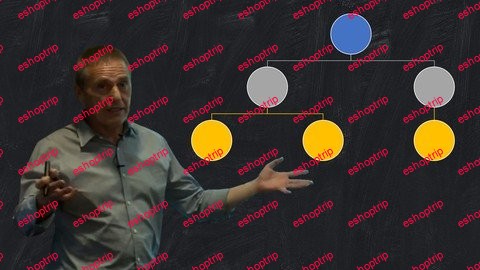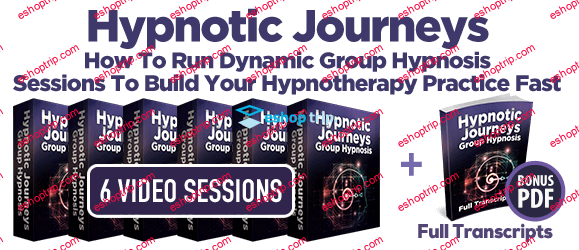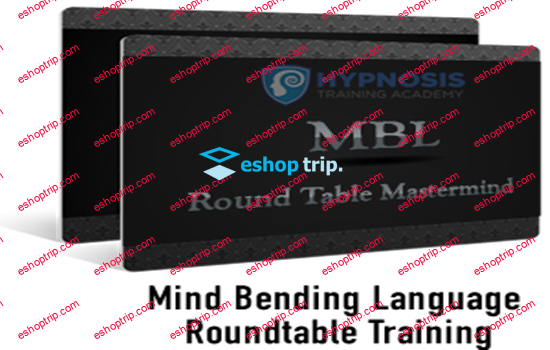Last updated 5/2021
MP4 | Video: h264, 1280×720 | Audio: AAC, 44.1 KHz
Language: English | Size: 26.8 GB | Duration: 22h 37m
Learn how to use NLP in your personal and professional life
What you’ll learn
Learn an advanced dynamic of change model
Become a facilitator for change in your personal and professional life and empower others to change for the better
Become your best self, even in difficult situations
Make positive changes in your way of thinking, feeling and acting
Turn the problems and obstacles to success Increase the speed of your learning
The foundation and the development of beliefs
Learn to identify and modify limiting beliefs
Master goal setting strategy
Apply sub modalities and pacing (Matching or Mirroring)
Learn about inductive and deductive thinking Identify unhelpful patterns of thoughts
The core identity coaching model
Work with re-imprinting
Communication skills improvement methods
Learn how to use modeling in creating new results
Understand people communication preferences
Create instant relationships with others
See, hear and understand more effectively by sharpening your senses
Learn the NLP Coaching general framework and build an efficient coaching practice
Recognize and understand how other people react to you and your actions
Understand your opponents and competitors
Become more efficient in your personal and professional environment
Make better decisions privately and at work by future-pacing your life
Requirements
Must use a PC, Mac or Mobile Device
No prior knowledge of NLP is required
Description
Hello and welcome to our course!In this 1st part of the Neuro-linguistic programming (NLP) certificate course I want to introduce you in the NLP universe and how you can change your life by using this method.After completing it, you will:understand NLP: role, purpose and limitationspractice NLP: different methods and their purposeunderstand the role of your beliefs and how they limit youknow who to change your beliefshow to set goals that will get achievedunderstand the self concept: who I am, how others see me, who I want to beknow what cognitive disorders are, and how to eliminate themAll the above mentioned subjects are treated in 4 sections:In section 1 you will learn about the foundation of NLPIn section 2 you will learn about beliefs development and interventionsIn section 3 you will learn about changing perceptions and beliefs interventionsIn section 4 you will learn about belief modification and deconstruction interventionsSome lessons have materials attached to help you better understand and practice what you just learned. For best results, please use each material attached as mentioned.Let us help you take the best out of you and improve your personal and professional life!We look forward to have you enrolled in our course!Thank you for choosing us!
Overview
Section 1: NLP MASTER PRACTITIONER foundation
Lecture 1 Introduction
Lecture 2 The motivation to study NLP Master Practitioner. Why NLP
Lecture 3 Master The ABC’s of NLP (part 1)
Lecture 4 Master The ABC’s of NLP (part 2)
Lecture 5 Master NLP Master Presuppositions (part 1)
Lecture 6 Master NLP Master Presupositions (part 2)
Lecture 7 Fundamentals of change intro
Lecture 8 Fundamentals of change
Lecture 9 Dilts logical levels
Lecture 10 Over-analyzing information
Lecture 11 Egans framework for problem solving interventions (part 1)
Lecture 12 Egans framework for problem solving interventions (part 2)
Lecture 13 Kolb’s learning styles
Lecture 14 Kolb’s type of learners
Lecture 15 Join Knowledge sharing Academy Facebook group video
Section 2: Beliefs development and interventions
Lecture 16 NLP Coaching as a partnership
Lecture 17 Belief definition and origin
Lecture 18 Belief development
Lecture 19 About beliefs foundation
Lecture 20 Limiting or irrational beliefs
Lecture 21 Intro to Questions to Identify Limiting Beliefs demo 1 with Ana
Lecture 22 Questions to Identify Limiting Beliefs demo 1 with Ana
Lecture 23 Analyse demo question limiting beliefs
Lecture 24 The Timeline of Limiting Beliefs (part 1)
Lecture 25 The Timeline of Limiting Beliefs (part 2)
Lecture 26 The timeline Anchors and re-imprinting (part 1)
Lecture 27 The timeline Anchors and re-imprinting (part 2)
Lecture 28 Beliefs roots (part 1)
Lecture 29 Beliefs roots (part 2)
Lecture 30 Setting Stretch Goals
Lecture 31 Make a new stretch goal intro
Lecture 32 Setting Stretch Goals Demonstration
Lecture 33 Ending to Stretching goals
Lecture 34 Demonstration Analyse
Lecture 35 Intro to purpose and dimension of existence Maslow
Lecture 36 Purpose and dimensions of existence Maslow
Lecture 37 Welcome to Facebook community group
Section 3: Changing Perceptions and beliefs interventions
Lecture 38 The self concept
Lecture 39 The dimensions of self concept (part 1)
Lecture 40 The dimensions of self concept (part 2)
Lecture 41 The dimensions of self concept (part 3)
Lecture 42 Modes of Perspective
Lecture 43 Demonstration of different modes of perspective with Anna
Lecture 44 Demonstration analyse with Ana
Lecture 45 Existential thinking
Lecture 46 Frames of mind
Lecture 47 Associating and dissociating
Lecture 48 Perceptual Pacing and benefits (part 1)
Lecture 49 Perceptual Pacing and benefits (part 2)
Lecture 50 Perceptual Pacing and benefits (part 3)
Lecture 51 Future pacing
Lecture 52 Examples of PP
Lecture 53 What to avoid in PP (part 1)
Lecture 54 What to avoid in PP (part 2)
Lecture 55 Perceptual Pacing Demonstration (part 1)
Lecture 56 Perceptual Pacing Demonstration (part 2)
Lecture 57 Perceptual Pacing Demonstration Analyse
Lecture 58 Inductive V’s Deductive Thinking (part 1)
Lecture 59 Inductive V’s Deductive Thinking (part 2)
Lecture 60 NLP Meta-model violations (cognitive distortions) (part 1)
Lecture 61 NLP Meta-model violations (cognitive distortions) (part 2)
Lecture 62 NLP Meta-model violations (cognitive distortions) (part 3)
Lecture 63 NLP Meta-model violations (cognitive distortions) (part 4)
Lecture 64 Cognitive distortions (part 1)
Lecture 65 Cognitive distortions (part 2)
Lecture 66 Refraiming
Lecture 67 Entry Six steps refraiming process demonstration
Lecture 68 Six steps refraiming process demonstration
Lecture 69 Utilize NLP Meta-Programs Self growth (part 1)
Lecture 70 Utilize NLP Meta-Programs Self growth (part 2)
Lecture 71 Socratic Questioning Demonstration
Section 4: Belief modification and deconstruction interventions
Lecture 72 Belief change based on the fundamental model of NLP (part 1)
Lecture 73 Belief change based on the fundamental model of NLP (part 2)
Lecture 74 Belief change based on the fundamental model of NLP (part 3)
Lecture 75 Belief change based on the fundamental model of NLP -The Cheat Sheet 2
Lecture 76 Investigating Current Beliefs (part 1)
Lecture 77 Investigating Current Beliefs (part 2)
Lecture 78 The Belief Modification Process (part 1)
Lecture 79 The Belief Modification Process (part 2)
Lecture 80 Parental Timeline Re-Imprinting (part 1)
Lecture 81 Parental Timeline Re-Imprinting (part 2)
Lecture 82 Parental Timeline Re-Imprinting (part 3)
Lecture 83 Parental Timeline Re-Imprinting (part 4)
Lecture 84 Parental Timeline Re-Imprinting (part 5)
Lecture 85 S. Freud: The Iceberg Model (part 1)
Lecture 86 S. Freud: The Iceberg Model (part 2)
Lecture 87 S. Freud: The Iceberg Model (part 3)
Lecture 88 S. Freud: The Iceberg Model (part 4)
People with an interest in how to develop their communication skills,People who want to discover how to deal with difficult situations,People who want to identify and overcome their limiting beliefs
HOMEPAGE
https://anonymz.com/?https://www.udemy.com/course/nlp-master-practitioner-certificate-1/











Reviews
There are no reviews yet.